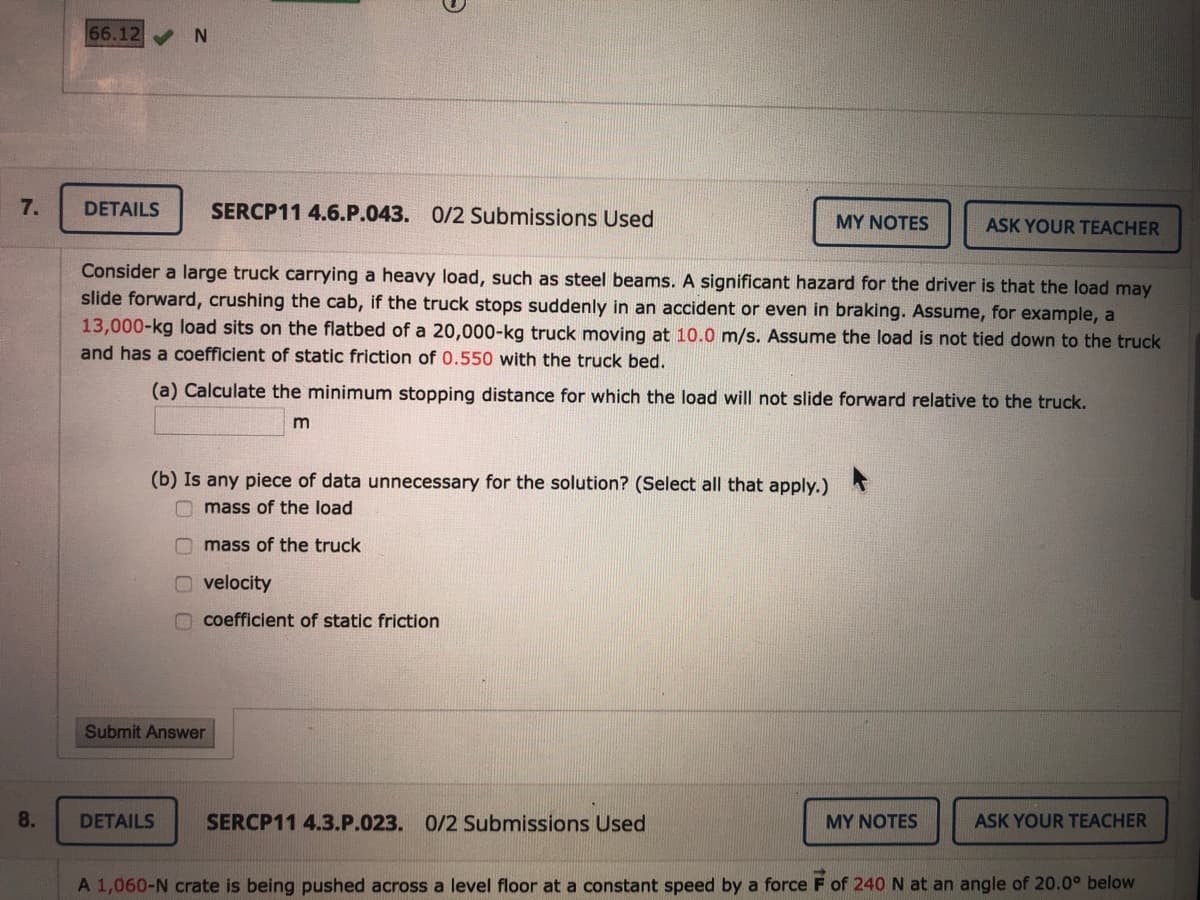Consider a large truck carrying a heavy load, such as steel beams. A significant hazard for the driver is that the load may slide forward, crushing the cab, if the truck stops suddenly in an accident or even in braking. Assume, for example, a 13,000-kg load sits on the flatbed of a 20,000-kg truck moving at 10.0 m/s. Assume the load is not tied down to the truck and has a coefficient of static friction of 0.550 with the truck bed. (a) Calculate the minimum stopping distance for which the load will not slide forward relative to the truck. m (b) Is any piece of data unnecessary for the solution? (Select all that apply.) O mass of the load O mass of the truck O velocity O coefficient of static friction
Consider a large truck carrying a heavy load, such as steel beams. A significant hazard for the driver is that the load may slide forward, crushing the cab, if the truck stops suddenly in an accident or even in braking. Assume, for example, a 13,000-kg load sits on the flatbed of a 20,000-kg truck moving at 10.0 m/s. Assume the load is not tied down to the truck and has a coefficient of static friction of 0.550 with the truck bed. (a) Calculate the minimum stopping distance for which the load will not slide forward relative to the truck. m (b) Is any piece of data unnecessary for the solution? (Select all that apply.) O mass of the load O mass of the truck O velocity O coefficient of static friction
University Physics Volume 1
18th Edition
ISBN:9781938168277
Author:William Moebs, Samuel J. Ling, Jeff Sanny
Publisher:William Moebs, Samuel J. Ling, Jeff Sanny
Chapter5: Newton's Law Of Motion
Section: Chapter Questions
Problem 5.4CYU: Check Your Understanding A 550-kg sports car collides with a 2200-kg truck, and during the...
Related questions
Question

Transcribed Image Text:Consider a large truck carrying a heavy load, such as steel beams. A significant hazard for the driver is that the load may
slide forward, crushing the cab, if the truck stops suddenly in an accident or even in braking. Assume, for example, a
13,000-kg load sits on the flatbed of a 20,000-kg truck moving at 10.0 m/s. Assume the load is not tied down to the truck
and has a coefficient of static friction of 0.550 with the truck bed.
(a) Calculate the minimum stopping distance for which the load will not slide forward relative to the truck.
m
(b) Is any piece of data unnecessary for the solution? (Select all that apply.)
O mass of the load
O mass of the truck
O velocity
O coefficient of static friction
Expert Solution
This question has been solved!
Explore an expertly crafted, step-by-step solution for a thorough understanding of key concepts.
This is a popular solution!
Trending now
This is a popular solution!
Step by step
Solved in 3 steps with 1 images

Knowledge Booster
Learn more about
Need a deep-dive on the concept behind this application? Look no further. Learn more about this topic, physics and related others by exploring similar questions and additional content below.Recommended textbooks for you

University Physics Volume 1
Physics
ISBN:
9781938168277
Author:
William Moebs, Samuel J. Ling, Jeff Sanny
Publisher:
OpenStax - Rice University

University Physics Volume 1
Physics
ISBN:
9781938168277
Author:
William Moebs, Samuel J. Ling, Jeff Sanny
Publisher:
OpenStax - Rice University